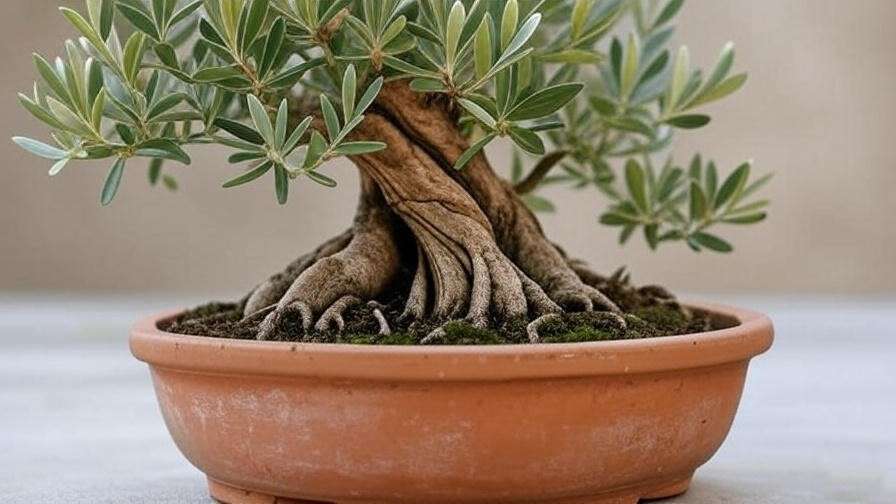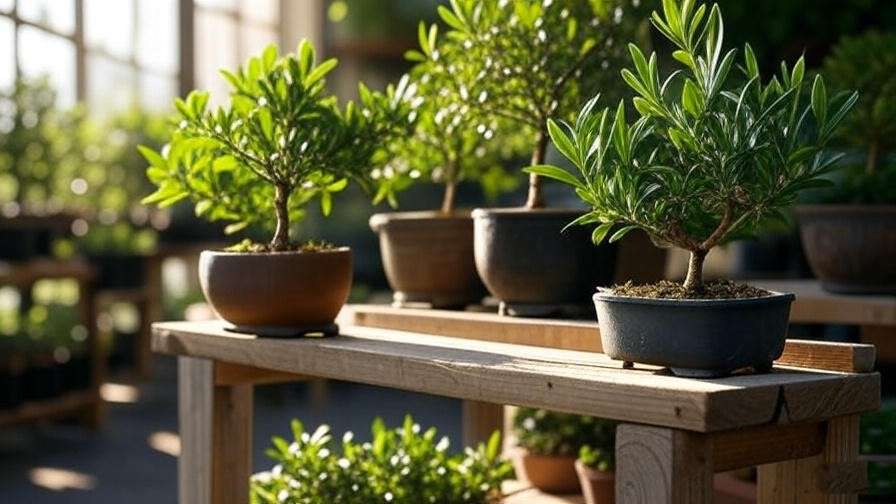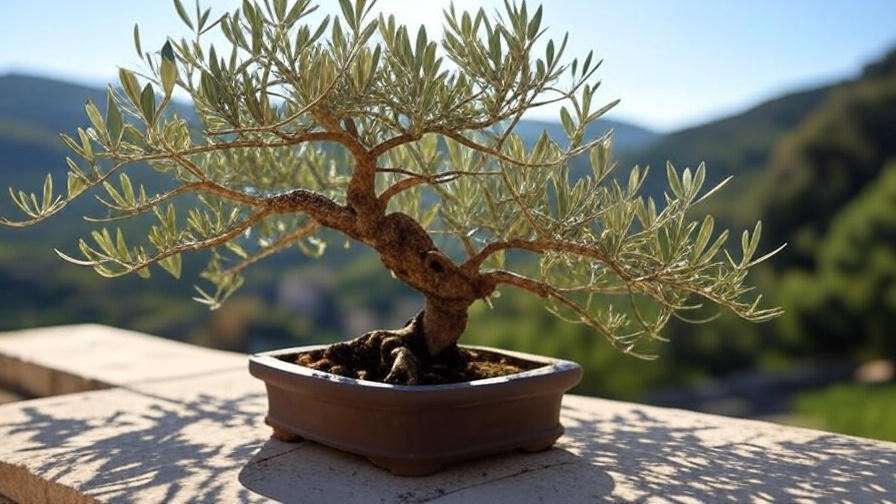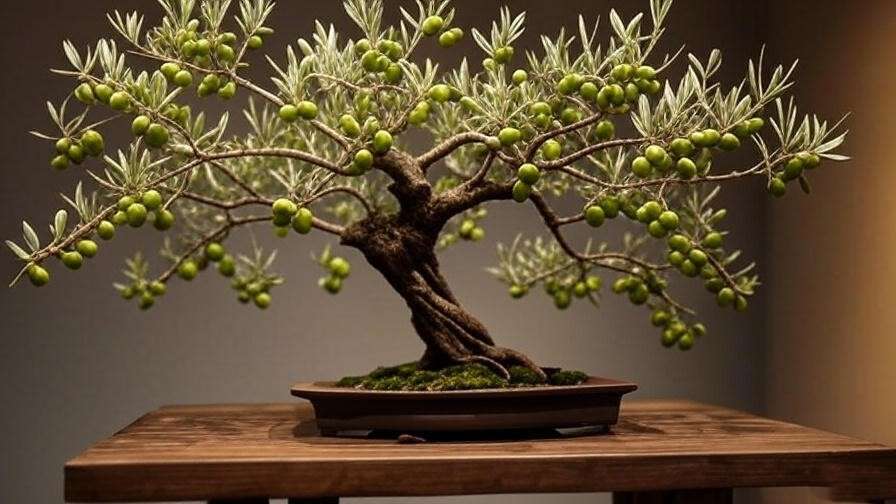Imagine transforming a tiny olive tree bonsai into a living work of art, its gnarled trunk and silvery leaves whispering tales of Mediterranean groves right in your home. This isn’t just a plant—it’s a journey into the ancient art of bonsai, blending patience, skill, and nature’s beauty. Whether you’re a beginner or a seasoned gardener, mastering olive tree bonsai care unlocks a rewarding hobby that elevates any space. In this comprehensive guide, we’ll walk you through every step to ensure your olive tree bonsai thrives, from choosing the perfect specimen to shaping it into a miniature masterpiece. Backed by decades of bonsai expertise and Mediterranean horticultural traditions, this article delivers practical, actionable advice to solve real challenges and help you succeed.
1. Understanding the Olive Tree Bonsai 🌳
1.1 What Makes Olive Tree Bonsai Special? ✨
The olive tree (Olea europaea) is a standout choice for bonsai enthusiasts. Its rugged, twisted trunk and silvery-green foliage evoke the sun-drenched landscapes of Greece or Italy, making it a visually striking addition to any collection. Unlike other bonsai species, olive trees are evergreen, offering year-round beauty. Their small, oval leaves and slow growth rate make them ideal for miniaturization, while their resilience suits both novice and experienced growers.
Olive trees carry deep cultural significance, symbolizing peace and prosperity in Mediterranean traditions. Historically, they’ve been cultivated for millennia, with some living specimens exceeding 1,000 years. This longevity translates beautifully into bonsai, where an olive tree can become a multi-generational heirloom with proper care.

1.2 Why Choose an Olive Tree Bonsai? 🌟
Olive tree bonsai combines aesthetic appeal with practical benefits. Their compact size (typically 12–24 inches tall) fits perfectly in small spaces like apartments or offices. They’re relatively forgiving for beginners, provided you meet their basic needs—sunlight, well-draining soil, and minimal overwatering. Compared to finicky species like azaleas or delicate junipers, olive bonsai are hardy and adaptable, thriving in warm, sunny conditions.
For hobbyists, the olive bonsai offers a unique challenge: balancing its natural, rugged beauty with the refined artistry of bonsai styling. It’s a plant that rewards patience, growing more characterful with each passing year.
2. Getting Started: Choosing Your Olive Tree Bonsai 🛒
2.1 Selecting a Healthy Olive Tree Bonsai 🩺
Choosing a healthy olive tree bonsai is the foundation of success. Look for a tree with a thick, textured trunk, as this indicates age and character. The leaves should be vibrant, silvery-green, and free from spots or yellowing. Check the roots (if visible) for firmness and a healthy spread—soggy or blackened roots signal trouble.
Popular varieties for bonsai include Arbequina (compact and fruitful), Mission (hardy and adaptable), and Picholine (elegant foliage). Visit local nurseries or trusted online retailers like Bonsai Boy or Eastern Leaf to ensure quality. If possible, inspect the tree in person to assess its overall vigor.

2.2 Where to Buy and What to Avoid 🚫
Reputable sources are key to avoiding disappointment. Established bonsai nurseries, such as Brussel’s Bonsai or Herons Bonsai, offer healthy specimens with detailed care instructions. Local garden centers may carry olive bonsai, but ensure they specialize in bonsai to avoid mass-produced, low-quality trees. Online marketplaces like Etsy or Amazon can be risky—stick to sellers with strong reviews and clear return policies.
Avoid trees with sparse foliage, weak branches, or signs of pests (tiny webs or sticky residue). A poorly shaped bonsai or one in a cheap, non-draining pot is a red flag. Expect to spend $50–$150 for a quality beginner olive bonsai, balancing cost with health.
3. Essential Care Requirements for Olive Tree Bonsai 🌞
3.1 Light and Placement ☀️
Olive tree bonsai crave sunlight, mimicking their Mediterranean origins. Aim for 6–8 hours of direct sunlight daily. Outdoors, place them in a south-facing spot with unobstructed light. Indoors, a sunny windowsill or grow light (12,000–20,000 lumens) is essential, especially in winter. Rotate the tree every few weeks to ensure even light exposure.
For urban dwellers, balcony or rooftop placement works well, but protect from strong winds. In colder climates, bring indoor bonsai outside during warm months (above 50°F) to boost growth. Avoid dark corners or shaded areas, as insufficient light causes leggy growth and weak branches.

3.2 Watering Techniques 💧
Watering is where many beginners stumble. Olive bonsai prefer slightly moist soil but hate waterlogged roots. Water thoroughly when the top 1 inch of soil feels dry, using a watering can with a fine spout to avoid disturbing the soil. Ensure excess water drains completely—never let the pot sit in a saucer of water.
Use a moisture meter for precision, or test by touch: dry soil crumbles, while moist soil holds together. Overwatering leads to root rot, while underwatering causes leaf drop. In hot weather, water daily; in cooler months, every 3–5 days. Adjust based on your climate and indoor humidity.
3.3 Soil and Potting 🏺
A well-draining soil mix is non-negotiable. Combine 50% akadama, 25% pumice, and 25% lava rock for optimal drainage and aeration. Avoid heavy, water-retaining soils like garden dirt. Bonsai-specific mixes are available at specialty retailers or can be mixed at home.
Choose a shallow, wide pot to mimic the tree’s natural root spread and enhance its aesthetic. Unglazed ceramic pots in earthy tones complement the olive’s rugged look. Repot every 2–3 years in early spring, trimming 20–30% of the roots to encourage new growth. Use a root rake and chopstick to gently tease out roots, and refresh the soil completely.
3.4 Temperature and Humidity 🌡️
Olive bonsai thrive in temperatures between 50°F and 85°F (10°C–29°C). They tolerate brief dips to 40°F but need protection from frost—move indoors or use a cold frame in winter. In summer, shield from scorching heat above 90°F by providing afternoon shade.
Maintain moderate humidity (40–60%). In dry climates or heated homes, mist the foliage daily or place a humidity tray (a shallow tray with pebbles and water) beneath the pot. Avoid misting in direct sunlight to prevent leaf burn. Good airflow is crucial to prevent fungal issues.
4. Pruning and Shaping Your Olive Tree Bonsai ✂️
4.1 Pruning Basics 🪴
Pruning keeps your olive bonsai healthy and aesthetically pleasing. Perform maintenance pruning in spring or early summer, removing dead, damaged, or overly dense branches with sharp bonsai shears. Focus on preserving the tree’s natural, gnarled look—avoid over-pruning, which can stress the tree.
Structural pruning, done every 1–2 years, shapes the overall form. Remove branches that disrupt the desired silhouette, such as those crossing or growing inward. Always cut at a 45-degree angle just above a leaf node to encourage new growth. Sterilize tools with rubbing alcohol to prevent disease spread.

4.2 Wiring for Shape 🪢
Wiring allows you to sculpt branches into elegant curves. Use aluminum wire (1–3 mm thick) for flexibility, wrapping at a 45-degree angle around branches. Bend gently to avoid snapping, and check monthly to prevent wire cutting into the bark. Remove wire after 3–6 months, once the branch holds its shape.
Timing matters: wire in spring when branches are pliable. Avoid wiring during peak summer growth or winter dormancy. For inspiration, study classic bonsai styles like informal upright (moyogi) or cascade (kengai), which suit the olive’s rugged charm.
4.3 Creating a Natural, Aged Look 🌲
Olive bonsai shine when styled to mimic ancient, weathered trees. Encourage a gnarled trunk by selective pruning and allowing natural twists to develop over time. Use jin (deadwood) techniques to create aged, weathered branches, applying lime sulfur to preserve and whiten the wood.
For inspiration, look at award-winning olive bonsai, like those displayed at the World Bonsai Convention. A 2019 exhibit featured a 30-year-old Arbequina bonsai with a windswept style, its twisted trunk and sparse foliage evoking a coastal olive grove. Aim for balance: a harmonious blend of foliage and exposed wood.
5. Feeding and Fertilizing Your Bonsai 🍽️
5.1 Nutrient Needs 🥗
To keep your olive tree bonsai thriving, it needs a steady supply of nutrients, particularly nitrogen (for foliage), phosphorus (for roots), and potassium (for overall vigor). A balanced fertilizer with an NPK ratio of 10-10-10 or 5-5-5 works well for beginners. During the growing season (spring to early fall), fertilize monthly to support active growth. In winter, reduce to every 6–8 weeks, as the tree’s metabolism slows.
Choose a liquid fertilizer for quick absorption or slow-release pellets for convenience. Brands like Bonsai Pro or Biogold are formulated specifically for bonsai, ensuring precise nutrient delivery without overwhelming the tree’s compact root system.
5.2 Organic vs. Synthetic Fertilizers 🌿
Organic fertilizers, such as fish emulsion or compost tea, enrich the soil naturally and promote long-term health. They release nutrients slowly, reducing the risk of root burn, and align with sustainable gardening practices. Synthetic fertilizers, like Miracle-Gro, offer faster results but require careful dilution (half-strength is ideal) to avoid overfeeding.
For olive bonsai, organic options are often preferred for their gentle impact. Apply liquid fertilizers after watering to prevent root shock, and follow the product’s instructions for dosage. Over-fertilizing can cause leaf burn or excessive growth, disrupting the bonsai’s delicate balance.
6. Common Olive Tree Bonsai Problems and Solutions 🐞
6.1 Pests and Diseases 🦟
Olive tree bonsai are hardy but not immune to pests. Common culprits include spider mites (tiny webs on leaves), aphids (sticky residue), and scale insects (small, waxy bumps). Regular inspection is your first defense—check undersides of leaves and branch junctions weekly.
Prevent pests by maintaining good airflow and avoiding overly humid conditions. If pests appear, treat with neem oil (diluted per instructions) or insecticidal soap, applied in the evening to avoid leaf burn. For fungal issues like powdery mildew, ensure proper drainage and apply a bonsai-safe fungicide. Always isolate affected trees to prevent spread.
6.2 Yellowing Leaves and Other Issues 🍂
Yellowing leaves are a common concern and often signal overwatering, nutrient deficiency, or insufficient light. Diagnose the cause by checking soil moisture (soggy soil indicates overwatering), light exposure (less than 6 hours daily is inadequate), or recent fertilization (missed feedings can deplete nutrients).
To fix overwatering, let the soil dry out and improve drainage. For nutrient issues, apply a balanced fertilizer and monitor response over 2–3 weeks. If light is the problem, relocate to a sunnier spot or supplement with a grow light. A struggling bonsai can often be revived with prompt action—don’t give up!
6.3 Seasonal Care Challenges ❄️☀️
Winter poses risks like frost damage and low humidity. Move outdoor bonsai to a sheltered area (like a garage) when temperatures drop below 40°F, or use a cold frame. Indoors, maintain humidity with a tray of pebbles and water, and keep away from heating vents.
In summer, protect from intense heat above 90°F by providing afternoon shade or moving to a cooler spot. Gradual acclimation is key when transitioning between indoor and outdoor environments—sudden changes can shock the tree. For example, when moving outside in spring, expose the bonsai to increasing sunlight over 7–10 days.
7. Advanced Tips for Thriving Olive Tree Bonsai 🌟
7.1 Encouraging Fruit Production 🍈
Mature olive tree bonsai can produce small, decorative olives, adding to their charm. Fruiting requires a healthy, mature tree (at least 5–7 years old), adequate sunlight, and proper pollination. If grown indoors, hand-pollinate by gently brushing flowers with a small paintbrush to transfer pollen.
Fruit production can strain the tree, so thin fruits selectively to maintain vigor. Remove excess buds early in the season, leaving 2–3 per branch. While the olives are rarely edible due to their size and bitterness, they enhance the bonsai’s aesthetic. Monitor tree health closely, as fruiting demands extra nutrients.

7.2 Long-Term Maintenance 🕰️
A well-cared-for olive bonsai can live for decades, even centuries. Long-term success hinges on consistent care: regular repotting (every 3–5 years for mature trees), root pruning to prevent root-bound conditions, and refreshing the soil to maintain nutrient availability. Use a root hook to gently untangle roots during repotting, trimming no more than 20% to avoid stress.
Monitor trunk and branch development over time, refining the shape every few years to enhance its aged appearance. A 50-year-old olive bonsai from a Japanese collection, for instance, showcases a gnarled trunk achieved through decades of careful pruning and wiring—a testament to patient stewardship.
7.3 Styling for Shows and Competitions 🏆
Preparing an olive bonsai for display elevates it from hobby to art. Polish the pot with a soft cloth to remove dirt, and clean foliage with a gentle water spray to highlight the silvery leaves. Remove any dead leaves or debris from the soil surface for a pristine look.
Popular styling trends include the windswept style, mimicking trees shaped by coastal breezes, or the informal upright style, emphasizing natural curves. Bonsai judges value harmony between the tree, pot, and display table, so choose a pot that complements the tree’s character. For inspiration, study exhibits from the U.S. National Bonsai Exhibition, where olive bonsai often stand out for their rugged elegance.
8. FAQs About Olive Tree Bonsai ❓
- How long does it take to grow an olive tree bonsai?
Initial shaping takes 1–2 years, but full maturity, with a thick trunk and refined style, can take 5–10 years. Patience is key! - Can olive tree bonsai grow indoors?
Yes, with 6–8 hours of direct sunlight or a grow light. Maintain moderate humidity and avoid dry, heated air. - How often should I repot my bonsai?
Young trees need repotting every 2–3 years; mature trees every 3–5 years. Always repot in early spring before new growth. - What’s the biggest mistake beginners make?
Overwatering or neglecting light requirements. Use a moisture meter and ensure ample sunlight to avoid these pitfalls. - Can olive bonsai produce edible olives?
Yes, but the olives are small and often bitter. Prioritize tree health over fruit production for best results.
Conclusion 🌿
Growing a thriving olive tree bonsai is a rewarding journey that blends horticultural skill with artistic vision. By providing ample sunlight, mastering watering techniques, pruning thoughtfully, and addressing challenges like pests or yellowing leaves, you can cultivate a miniature masterpiece that lasts for generations. This guide, rooted in Mediterranean horticulture and bonsai expertise, equips you with everything you need to succeed—whether you’re a beginner or refining your skills.
Start your olive bonsai journey today with confidence. Share your progress in the comments or on social media to connect with fellow enthusiasts, and let your bonsai tell a story of patience and care. For more tips, explore our articles on bonsai tools, soil mixes, or Mediterranean plant care. Happy growing up! 🌱













